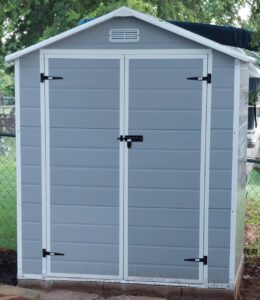By Don Diehl
Sapulpa Area Writer
Paul Slavens has a thing about trains — especially about old cabooses.
Slavens, 43 and a 1990 graduate of Sapulpa High School grew up next to the railroad tracks. From his back yard as a toddler on he watched and heard the great trains go by. The big diesel engines were pulling all kinds of cars — hopper, boxcars, tank, flat. Passenger trains had gone the way of steam locomotives. The famous Frisco had been taken over by Burlington Northern.
At any rate, as the boy would run to the back yard to greet the train the one car he was waiting for was the caboose. From it, he would receive waves from the brakeman and conductor.
The conductor was the chief of the train. The caboose usually carried at least those two train personnel. Earlier, the caboose served as the car that carried the train’s crew. The locomotive is where the engineer and fireman done their work. Sometimes, a second brakeman would be in the engine.
Slavens would wave until the train passed and the clickety-clack faded. But his memory hasn’t faded. In fact, his love for trains has probably increased over the years since boyhood.
“I was probably nine or 10 when it happened,” Slavens recalls. “One day there was no caboose.”
Suddenly they were gone. There was nobody on the end of the train to wave.
The nagging question as to what happened to the cabooses was one a lot of folks had. They along with Slavens would soon learn that technology and computers had come onboard — literally — replacing the need for a caboose and transferring the work of the conductor to an officed keyboard somewhere else.
The caboose also had gauges to indicate whether the air brake system was working properly, and held the rear marker lights for the train so it was visible to other trains at night.
But it wasn’t just the technological advances. The rail industry switched to roller bearings, which fail less often; went to central train control and power switches so it was no longer necessary for crews to throw switches at meets; and trains got longer — much longer — which made “slack action” worse and cabooses dangerous to ride.
Still there was something about the caboose that was sort of like the end of a good romance novel — a happy conclusion if you will, a period at the end of a sentence.
But it’s a part of train history that won’t go missing if Slavens has his way.
“There are thousands of cabooses all over the country,” Slavens said. “Most are in museums or attached to special museum or tour trains for novelty and history’s sake. Many, as in the case of the Frisco cabooses that used to travel these tracks, were given to cities or acquired by old railroad towns as tourist pieces one can usually find in city parks or historic downtowns. Sapulpa has a beautiful caboose at its TSU Park and Jim Hubbard Trolley Plaza (see separate story).
But many of the cabooses, just like donated box cars and old locomotives, if not well kept become “eyesores” instead of attractions.
Slavens found that some of the cities where the Frisco used to run, and which have become recipients of an old caboose, find the liabilities outweigh the benefits. Some town leaders seem to have lost their love for the historic rail road pieces.
“They want to get rid of them,” Slavens said.
So enter a young boy’s heart and memory.
Slavin who owns and operates Patriot Energy LLC, a Tulsa area oil production company, now owns four such cabooses — just like the ones that used to roll by his home near Oakhurst on Southwest Blvd.
The Slavens’ collection came from “Frisco “ towns in Kansas and Ohio. He has them on a lot along Old Highway 66 just north of Allen Bowden School.
Much restoration work has already been completed on one caboose originally built in 1969 — and probably one of the last in service when it quit running in the 1980s.
The Frisco logos painted over by BNSF will be restored. The glass work already is completed.
“With oil production the way it is right now,” Slaven says the restoration work will accelerate.
Once finished he will make the caboose available to museums and tourist trains such as Oklahoma City, Enid and Kansas City. It will be retrofitted to carry 16 or so train enthusiasts like Slavens. They can play the parts of conductor and brakeman at least in the role of waving at fans — small boys and all who have come out to see an old caboose.
Of the 92 cabooses manufactured for the Frisco Railroad (the ones that passed through here) Slavens has learned that only 14 still exist and he has four of them.
They are the ones with the center cupola. His first project will be repainted and rail ready by 2017.
Slavens also is as enthusiastic about old steam trains. He has taken tours on special trains, Amtrak trips, the Eastern Flyer and short rides at museums (the ones which still feature cabooses.)
Slavens also has the area’s largest electric model train collections. (That’s another story).
The father of four, three boys and a little girl, says the whole family likes trains but the five-year-old . . . “He loves trains maybe even more than I do.” (If that could be).
The Burlington Northern Railroad was a United States-based railroad company formed from a merger of four major U.S. railroads. Burlington Northern operated between 1970 and 1996. Its historical lineage begins in the earliest days of railroading with the chartering in 1848 of the Chicago and Aurora Railroad, a direct ancestor line of the Chicago, Burlington and Quincy Railroad, which lends Burlington to the names of various merger-produced successors. BN purchased the Atchison, Topeka and Santa Fe Railway on December 31, 1996 to form the Burlington Northern and Santa Fe Railway (later renamed BNSF Railway), which was owned by the Burlington Northern Santa Fe Corporation. That corporation was purchased by Berkshire Hathaway in 2009 which is controlled by investor Warren Buffett (also owners of the Tulsa World and a host of other newspapers). Dependent on who’s doing the counting, somewhere between 10 to 20 trains pass through Sapulpa each day.
DON DIEHL PHOTO
Area resident Paul Slavens with his caboose project. Slavens, a life-long train buff has four of just a few remaining Frisco cabooses. One in on the “fast rack” of restoration and is expected to be rail-ready in about 18 months.










